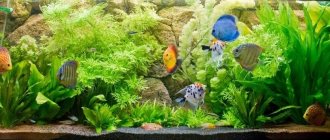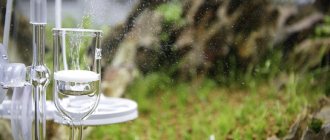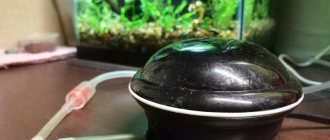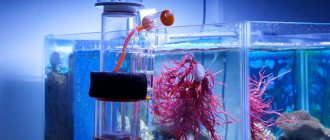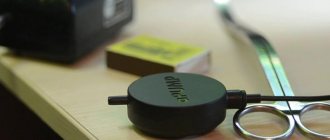Do you want to have a gorgeous aquarium with well-groomed plants at home? Then you need to choose the main soil and nutrient substrate, or substrate. The choice of nutritional support must be approached with extreme caution. After all, it contains the nutrients necessary for plant growth.
If the balance of the aquarium ecosystem is disturbed, then in addition to plants, algae will begin to flourish in the aquarium: blackbeard, Vietnamese, filamentous, xenococus. To prevent this from happening, it is necessary to plant not 2-3 plants, but almost the entire bottom of the container. You should also strictly follow all the recommendations of the nutrient soil manufacturer.
All nutrient soils are conditionally divided for beginner aquarists and professionals. Beginners should know that the so-called base soil is laid on top of the nutrient soil - gravel, quartzite, basalt, quartzite, quartz sand and others. A nutrient substrate provides nutrients to plants through their roots. Thanks to this, they grow well and quickly.
Those who decide to use nutrient soil for the first time should choose a soil that contains mostly microelements and a small amount of macroelements. If you already know what a nutrient substrate is and intend to plant plants that love “fatty” soil, then pay attention to nutrient soils that contain a lot of macro and microelements.
Note ! Substrates are not used in aquariums where several plants will grow. In such containers, nutritional tablets are placed under the roots of plants. If you decide to plant a lot of plants, and nutrient soil is placed under the main soil, then be sure to check the water parameters as often as possible.
How to choose a base soil
Soil is not only a biofilter for an aquarium; plant growth depends on its characteristics and properties. Therefore, it is necessary to select it carefully. Colored mixtures should not be used. It is best if it is natural soil with a fraction of 3-5 mm.
In sand, plant roots will sour, and in soil that is too coarse, plants will not be able to take root, and fish waste will accumulate between the stones, which over time will lead to an increase in the level of organic matter in the aquarium, further poisoning and even death of the fish. Unpretentious plants will grow in such soil: Vallisneria, Echinodorus, Cryptocoryne and others.
To feed the plants, nutritional tablets or clay balls are placed pointwise under the roots.
Marble chips and sea pebbles are not suitable for herbalists, as they make the water hard.
Before you buy soil, test it with vinegar. Take a few pebbles and put them in a glass with 9% vinegar. If the soil hisses or you can see bubbles coming from it, then such soil is not suitable for growing plants, as it increases water hardness. In addition, micro and macroelements necessary for plants to grow will not be absorbed by the plants when calcium is released from the soil.
Peat formation
Peat is formed as a result of a special anaerobic process of decomposition ( humification ) mainly from plant residues. It contains a large amount of organic and mineral substances formed over tens of thousands of years. balneotherapy products (which also includes peat water), only substances from approved natural sources are used, extracted precisely at the humification stage. The salts contained in mineral springs penetrate the peat substrate, enriching it with substances that have a beneficial effect on the human body.
Nutritious soils
There is a wide range of nutritional substrates in stores. Each major company offers its own line of substrates for herbalists. All of them are light and porous, due to which stagnation zones do not form in them. Below we name the most common nutrient substrates.
Tetra Active Substrate is an inexpensive primer ideal for beginners. Sintered clay is an excellent soil for aquarium plants and beneficial bacteria. Over time, the soil does not become compacted and plant roots do not rot. In addition, the substrate looks nice and has no sharp edges.
Dennerle DeponitMix Professional is a substrate consisting of quartz sand, clay, peat and granules that provide biofiltration in the aquarium. The soil contains nutrients and iron. Please note that this mixture does not contain macronutrients (nitrates and phosphates) that have a beneficial effect on algae growth.
Tetra Plant Complete Substrate concentrate is a nutrient support that contains: mineral elements, natural sand, peat and humic acids. Place soil in a container with a 2-centimeter layer. The substrate can be mixed with fine quartz or gravel.
AQUAYER nutrient support accelerates plant growth. It contains micronutrients. Doesn't sour over time. It is laid 1-2 cm thick, covered with 2-3 cm of base soil on top.
What does peat treat?
The thermal effect of peat effectively relieves pain and problems associated with arthritis, rheumatic diseases, and other diseases of the back, bones, and supports muscles and joints. It has a beneficial effect on nervous diseases, urological and gynecological diseases.
The healing substance improves the functioning of the digestive tract . Due to the presence of tannins, waxes, and enzymes, it helps treat skin diseases, including acne, psoriasis, and eczema. In general, its use has a positive effect on the immune system.
How to properly lay a nutrient substrate
Once again, we draw your attention to the fact that a nutrient substrate is only necessary for aquariums densely planted with plants. If you want the plants to grow in one corner, then use a nutrient substrate 1-3 cm thick only in this corner and separate it from the main soil of the rest of the bottom area with temporary plastic tape or a cardboard partition. Place a base soil 2-3 cm thick on top of the substrate. Decorate the rest of the container at your discretion with stones, driftwood, or leave it free.
Peat and peat water
Peat is accumulated, partially decomposed plant material. It contains predominantly organic matter ( cellulose ) and acids (pH 2-6). Peat originates in peat bogs - swamps. Its world reserves amount to 4 trillion. m³, covering 2% of the Earth's surface (about 3 million km²). The substance contains 8 billion terajoules (TJ) of energy.
Fertilizers in tablet form
The choice of tablets for the aquarium is varied: CO2 tablets, O2 oxygen tablets, peat tablets. And not all aquarists know why they are needed and whether they are needed at all.
So, let's start with O2 tablets. Hydrogen peroxide can be used instead. Take a syringe and add peroxide to the bottom of the aquarium, obtaining clean and cheap oxygen.
CO2 tablets will never replace a full carbon dioxide supply system. Therefore, it makes no sense to buy them three times a day. It's better to grow plants without them.
Let's talk in more detail about nutritional tablets. The popular Tetra PlantaStart and Tetra Plant Crypto tablets contain microelements and growth stimulants necessary for plants. Both products are intended for beginner aquarists only. The fact is that in beginner aquariums, nitrogen compounds and phosphates are present in any case and often in fairly large quantities.
If you add macroelements to such a jar, then from their excess the fish will be poisoned, and algae will begin to grow instead of plants. Therefore, before purchasing nutritional tablets, study their composition and buy what plants need - tablets with micro or macro elements.
The composition of peat tablets includes peat, biohomus and zeolite. Among such products, nutritional tablets from AQUAYER are the most popular. The composition includes microelements, humic acids. A tablet placed under the roots of the plant silts the soil and promotes the development of beneficial bacteria in it. Peat tablets are placed in loose herbal pots, where there is no need for a substrate. But this product also has a drawback. About a year after fertilizing the plants, the soil becomes heavily silted, and redox processes in it are disrupted. To improve the condition, you will need a good soil siphon with plant replanting.
Peat wraps
Peat wraps are a form of local treatment using a natural remedy. The advantage of the procedure is a slower and therefore gradual release of heat . Therefore, it can be used (after examination and general assessment of health) in patients with compensated circulatory disease. The immediate effect of peat wrap is pain relief and improved mobility. The temperature of the substance is 40-48°C, duration is 30 minutes .
Local effects:
- Hyperemia (increased blood flow).
- Antispasmodic effect (relaxation of increased muscle tension).
- Anesthesia.
- Softening tendons and ligaments.
- Immunobiological effect (stimulation of immune reactions).
- Bacteriostatic effect.
Recommendations for topical use:
- Inflammatory diseases of the musculoskeletal system, degenerative and post-traumatic origin.
- Neurological diseases.
- Respiratory diseases.
- Gastrointestinal diseases.
- Metabolic disorders.
- Urological diseases.
- Gynecological diseases.
Ceramic for aquarium filter
It is known that filtration of aquarium water can be: mechanical, biological and chemical. Ceramic rings are used to organize biological filtration. The structure of the material (unfired clay) from which ceramic fillers are made is porous, which promotes the development of a colony of beneficial nitrifying bacteria.
A novice aquarist should not neglect this type of biological filtration, since, in fact, ceramic rings are our tool through which we can adjust the biological balance in our aquarium.
This filter material is not washable, only occasionally rinsed in aquarium water! Ceramic is used in external filters, but can also be used in internal filters if the filter compartments allow it.
Currently, aquarium pet stores offer a huge selection of ceramic filter fillers. There are cheap ones - Chinese fillers, there are more expensive ones made in Poland and Germany
Since these rings serve for a long time, our recommendation is to choose more expensive, high-quality materials, paying attention to the quality of the structure - the porosity of the rings (m2/l). Ceramics from the company Tetra (Germany) are popular. We also recommend paying attention to Hydor SINTERED QUARTZ BIO-RINGS ceramics (Italy). Bio-ceramics (rings) Hydor for freshwater and marine aquariums are made of inert quartz
Due to their porous structure, Hydor bio-rings are an excellent filler for biological filters, where the main task is the development and growth of bacterial colonies over as large an area as possible. Ceramic granulate or ceramic chips work just as well as rings.
We also recommend paying attention to Hydor SINTERED QUARTZ BIO-RINGS ceramics (Italy). Hydor bio-ceramics (rings) for freshwater and marine aquariums are made of inert quartz. Due to their porous structure, Hydor bio-rings are an excellent filler for biological filters, where the main task is the development and growth of bacterial colonies over as large an area as possible. Ceramic granulate or ceramic chips work just as well as rings.
Contraindications
Due to the ability to accelerate blood flow, the use of peat wraps, baths, and drinking healthy liquids is not recommended for people who have had a stroke, suffer from cancer or cardiovascular diseases, or pregnant women.
It is necessary to refuse the use of peat water and balneological procedures using it in a number of cases:
- Febrile, infectious diseases.
- Severe heart and circulatory disorders.
- Hypertension.
- Inflammatory processes in the body.
- Injuries and other acute skin diseases.
Choosing land for an aquarium
The most important point, as I learned from materials on the Internet, is to choose the right land. Since in St. Petersburg the water is quite soft. I decided to choose land with a minimum peat content. It's not as simple as it turned out. One of the best options is ordinary soil from garden beds. But since the summer season was already closed at the time of setting up the aquarium, I had to look for land in flower shops. There is such a moment here. Almost all land sold in stores contains peat in one quantity or another. Even the purchased package of soil for testing, according to the seller’s assurances: “clean soil without peat,” in fact contained peat mixed with manure.
Ultimately, this land was chosen.
Choosing land for an aquarium
“Garden of Miracles” costs 30 rubles. "Rose" soil is nutritious. Completely ready. Neutral contains vermicompost. For growing ornamental plants.
Origin: the product is obtained as a result of the processing of organic substrates by earthworms with the addition of natural structuring components of macro and microelements. To improve air and moisture exchange, perlite (inert white granules) was added to the soil; the following characteristics of the soil were indicated on the packaging.
The content of the main elements is not less than:
Nitrogen (NH4+NO3) – 200 mg/liter
Phosphorus (P2O5) – 300 mg/liter
Potassium (K2O) – 350 mg/liter
When choosing land, the seller, noticing that I was closely studying the composition on the bag of soil, made the following comment: “What are you reading all that about?! All the same, the specified composition does not correspond to the contents! In general, I didn’t explain to him why it took me so long to re-read the contents of the packages; probably in his eyes I looked like a slightly touched flower grower. Having opened the packages at home, it turned out that the base of the soil was peat, fine sand and perlite.
I manually removed large peat fibers - I definitely didn’t like this mixture
Large peat fibers
The next day I decided to visit another garden-themed store and look for whatever it was...
In the evening, while walking the dog, I noticed that in the neighboring yard construction workers were landscaping the lawns and were just accepting trucks with soil. The land was brought in basically as I was trying to find. That is, it is land with a small clay content, and not peat as purchased. Another question is where it was brought from, but let's hope for the best.
There is no peat here
I collected two bags of soil brought for lawns. I chose stones and some roots came across such lumps of clay, I simply crushed them with my hands.
But you come across clay
I mixed it with purchased soil from the store. The result was a mixture like this, in the photo below you can see the difference: the dark layer of purchased soil on the top was taken from the future lawn.
Mixing soil from the lawn with purchased soil
We also bought charcoal – a package of 30 rubles.
Charcoal
I found a bag of stove ash I had saved from the summer. In my main 360 liter aquarium, I sometimes feed Echinodorus and Cryptocoryne with blue clay. I was thinking of mixing clay with ash. Now it will come in handy.
Ash from the stove
Add charcoal to the mixed soil, which I crushed a little beforehand.
I mix coal with soil
Added ash.
Plus ash
It is also recommended to add additives to the soil in the form of lime, chalk, sandstones, etc., that is, carbonates to alkalize the water and prevent it from acidifying. There was information that even ordinary eggshells are suitable. That's what I used in this case. I boiled it a little to remove the film-like residue, crumbled it and added it to the earthen mixture.
Eggshell with soil
Again, everything was thoroughly mixed; the soil was ready to be placed in the aquarium; it was pre-heated; I did not soak it.

